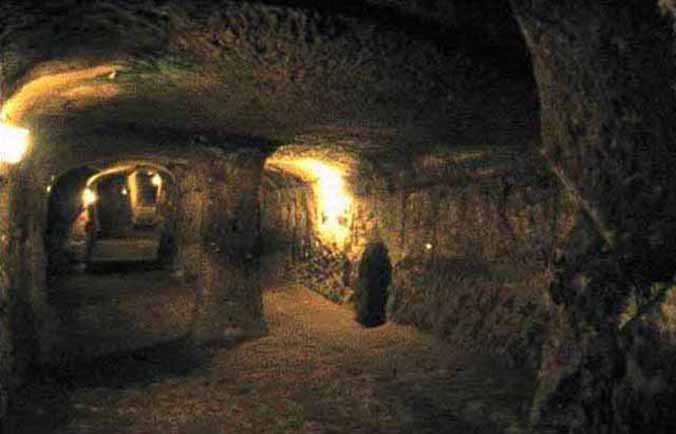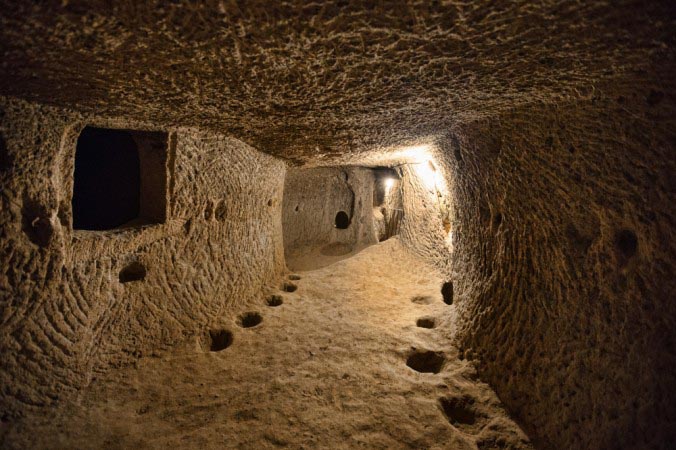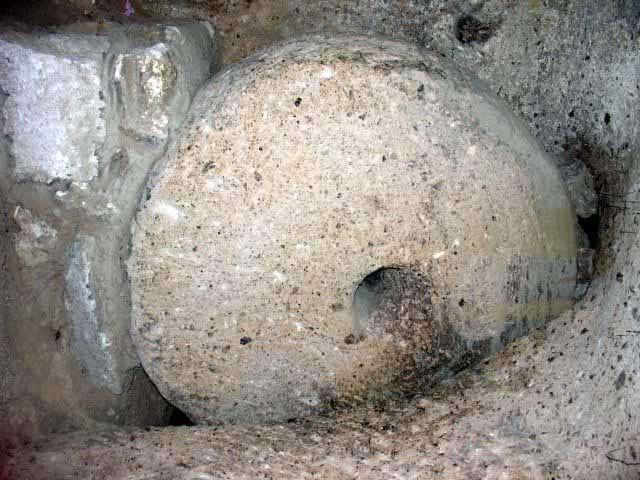



Derinkuyu is an ancient multi-level underground city in the Derinkuyu district in Nevuehir Province, Turkey. With its 13 floors extending to a depth of approximately 85 m, it was large enough to shelter thousands of people together with their livestock and food stores. It is the largest excavated underground city in Turkey and is part of a network of several underground complexes found across Cappadocia.
Since you cannot carbonate stone, it is hard to date the age of Derinkuyu Underground City.
Derinkuyu was first discovered in 1963 when a cave wall was opened revealing a passage way to an underground city thousands of years old and more than 280 feet deep.

The underground city at Derinkuyu could be closed from the inside with 1,000 pound stone doors which can only be opened and leveraged from the inside.
The complex has a total 13 stories which go deep into the ground, with ventilation shafts - small ventilation shafts that bring air to even the deepest levels. The large 55 m ventilation shaft appears to have been used as a well. The shaft also provided water to both the villagers above and, if the outside world was not accessible, to those in hiding.
Each floor could be closed off separately.
The city could accommodate between approximately 30,000 people and had all the usual amenities found in other underground complexes across Cappadocia, such as wine and oil presses, stables, cellars, storage rooms, refectories, and chapels. Between the third and fourth levels is a vertical staircase. This passage way leads to a cruciform church on the lowest level.
Unique to the Derinkuyu complex, and located on the second floor, is a spacious room with a barrel vaulted ceiling. It has been reported that this room was used as a religious school and the rooms to the left were studies.
First built in the soft volcanic rock of the Cappadocia region, possibly by the Phrygians in the 8th - 7th centuries B.C according to the Turkish Department of Culture, the underground city at Derinkuyu may have been enlarged in the Byzantine era. The city was connected with other underground cities through miles of tunnels.
To this day, no one is certain how it was created and what its original purpose was. Ancient Alien theorists speculate that it is thousands of years older than believed, and created by alien visitors then later abandoned the city.
Scholars believe Derinkuyu was the hiding place for the first Christians who were escaping from the persecution of the Roman empire. Some things discovered in these underground settlements belong to the Middle Byzantine Period, between the 5th and the 10th centuries A.D. It is speculated that number of underground settlements, generally used for taking refuge and for religious purposes, increased during this era. The Christian communities in the region may have taken refuge, closing the millstone doors, when they were subjected to Arab raids which started in the 7th century.
Nevuehir Province has several other historical underground cities. The cities and structures are carved out of unique geological formations. They were used by Christians as hiding places during times of persecution and raids. The locations are now archaeological tourist attractions. They remain generally unoccupied. In excess of 200 underground cities containing a minimum of two levels have been discovered in the area between Kayseri and Nevsehir. Some 40 of those contain a minimum of three levels or more. The troglodyte cities at Kaymaklı and Derinkuyu, are two of the best examples of habitable underground structures.
Kaymakli Underground City is contained within the citadel of Kaymakli in the Central Anatolia Region of Turkey. First opened to tourists in 1964, the village is about 19km from Nevuehir, on the Nevuehir-Nigde road. The ancient name was Enegup. The houses in the village are constructed around the nearly one hundred tunnels of the underground city. The tunnels are still used today as storage areas, stables, and cellars. The underground city at Kaymakli differs from Derinkuyu in terms of its structure and layout. The tunnels are lower, narrower, and more steeply inclined. Of the four floors open to tourists, each space is organized around ventilation shafts. This makes the design of each room or open space dependent on the availability of ventilation.
A stable is located on the first floor. The small size of the stable could indicate that other stables exist in the sections not yet opened. To the left of the stable is a passage with a millstone door. The door leads into a church. To the right of the stables are rooms, possibly living spaces.
Located on the second floor is a church with a nave and two apses. Located in front of the apses is a baptismal font, and on the sides along the walls are seating platforms. Names of people contained in graves here coincide with those located next to the church, which supports the idea that these graves belonged to religious people. The church level also contains some living spaces.
The third floor contains the most important areas of the underground compound: storage places, wine or oil presses, and kitchens. The level also contains a remarkable block of andesite with relief textures. Recently it was shown that this stone was used as a pot to melt copper. The stone was hewn from an andesite layer within the complex. In order for it to be used in metallurgy, fifty-seven holes were carved into the stone. The technique was to put copper ore into each of the holes (about 10cm in diameter) and then to hammer the ore into place. The copper was probably mined between Aksaray and Nevsehir. This mine was also used by Asilikhoyuk, the oldest settlement within the Cappadocia Region.
The high number of storage rooms and areas for earthenware jars on the fourth floor indicates some economic stability. Kaymakl is one of the largest underground settlements in the region. The large area reserved for storage in such a limited area appears to indicate the need to support a large population underground. Currently only a fraction of the complex is open to the public.
According to ancient alien theory these underground structures represent an advanced civilization that existed thousands of years ago and may be the oldest known civilization history has yet to disclose. They most likely connect with extraterrestrial creators and visitors.
To me the figures at Gobekli Tepe, Karahan Tepe, in Turkey as well as similar giant figures found across the planet represent artificial intelligence of some kind that visited the planet long ago. They are part of Earth's mythology and possibly its history.
if you look at them as part of simulation theory, they depict different inserts in the simulation of our reality.
ANCIENT AND LOST CIVILIZATIONS